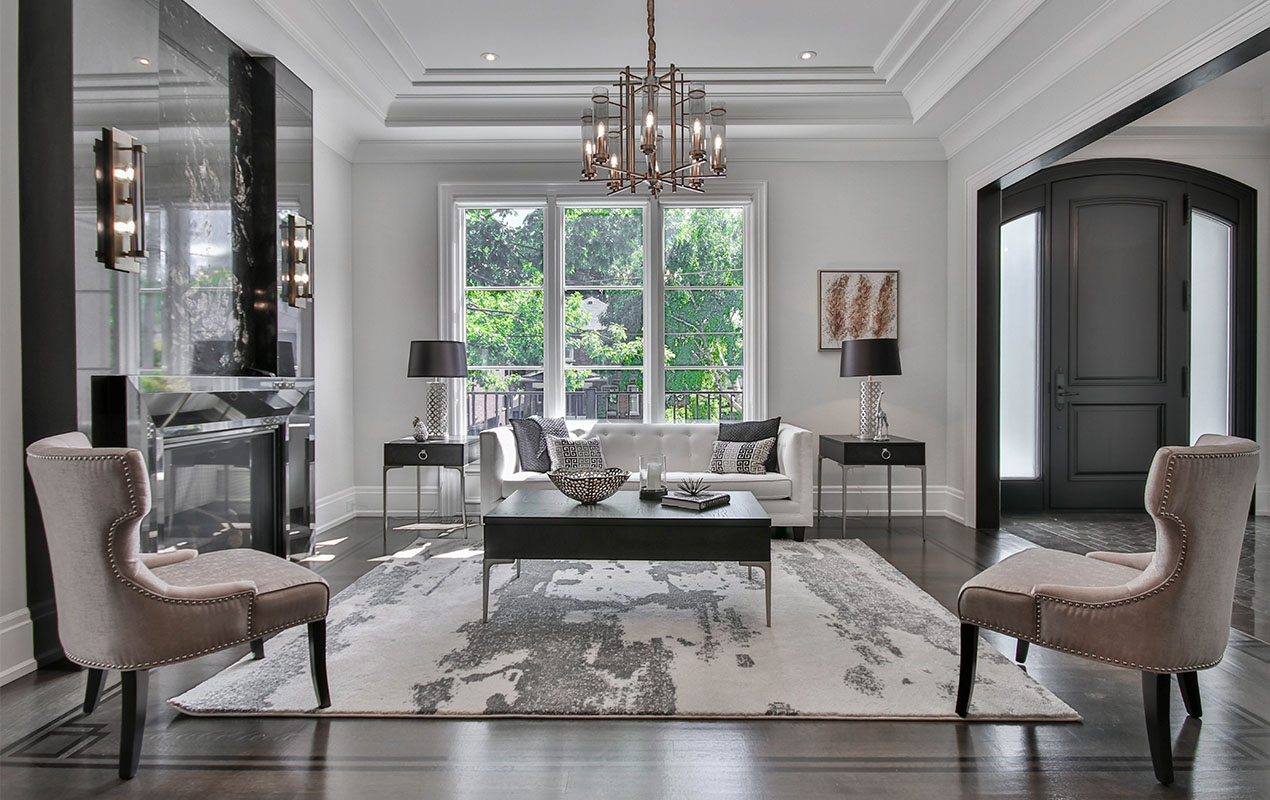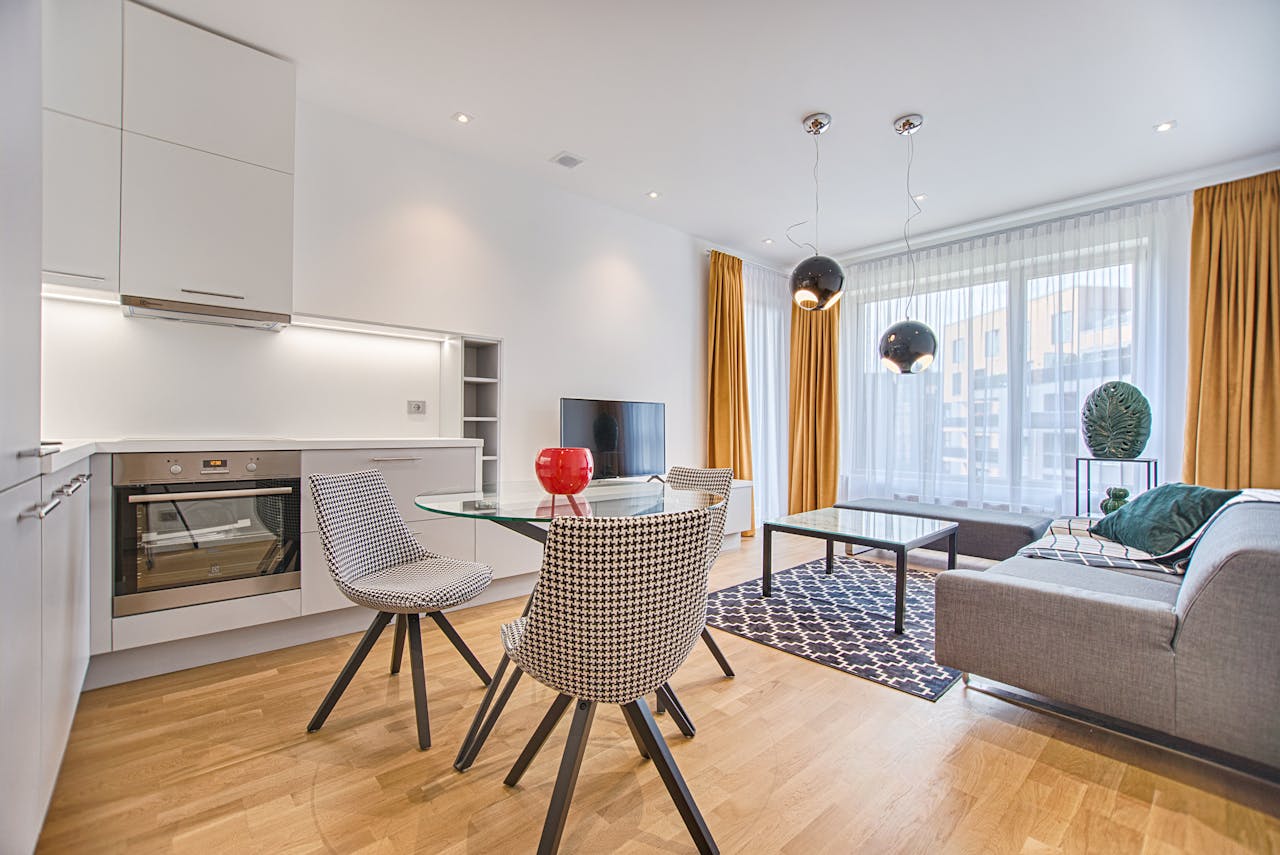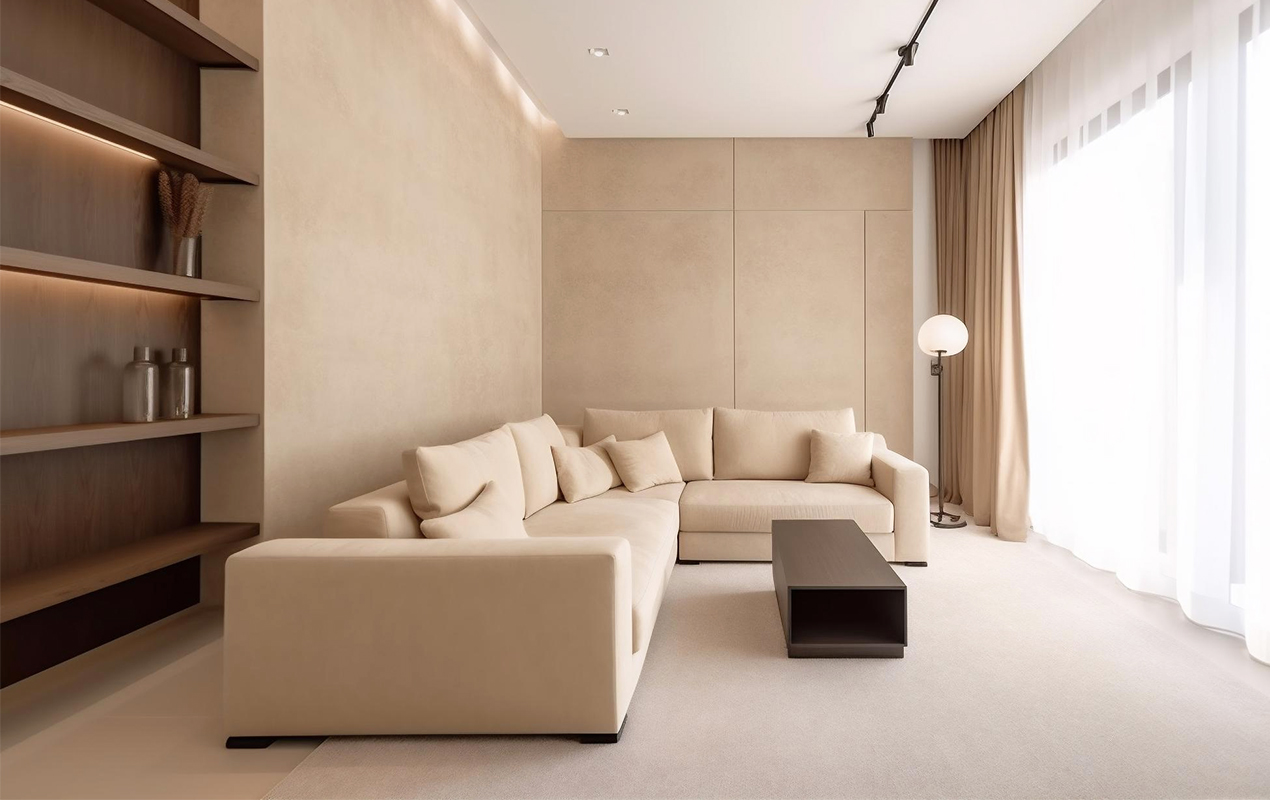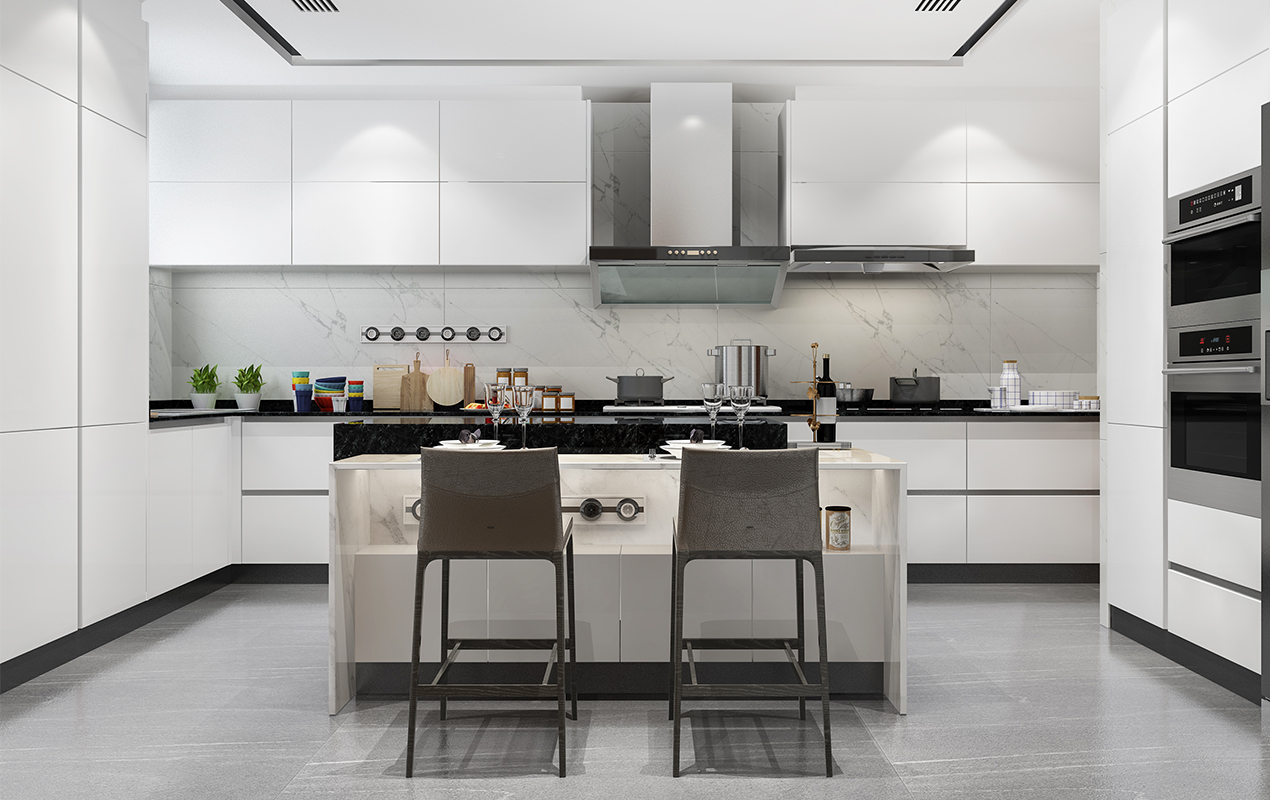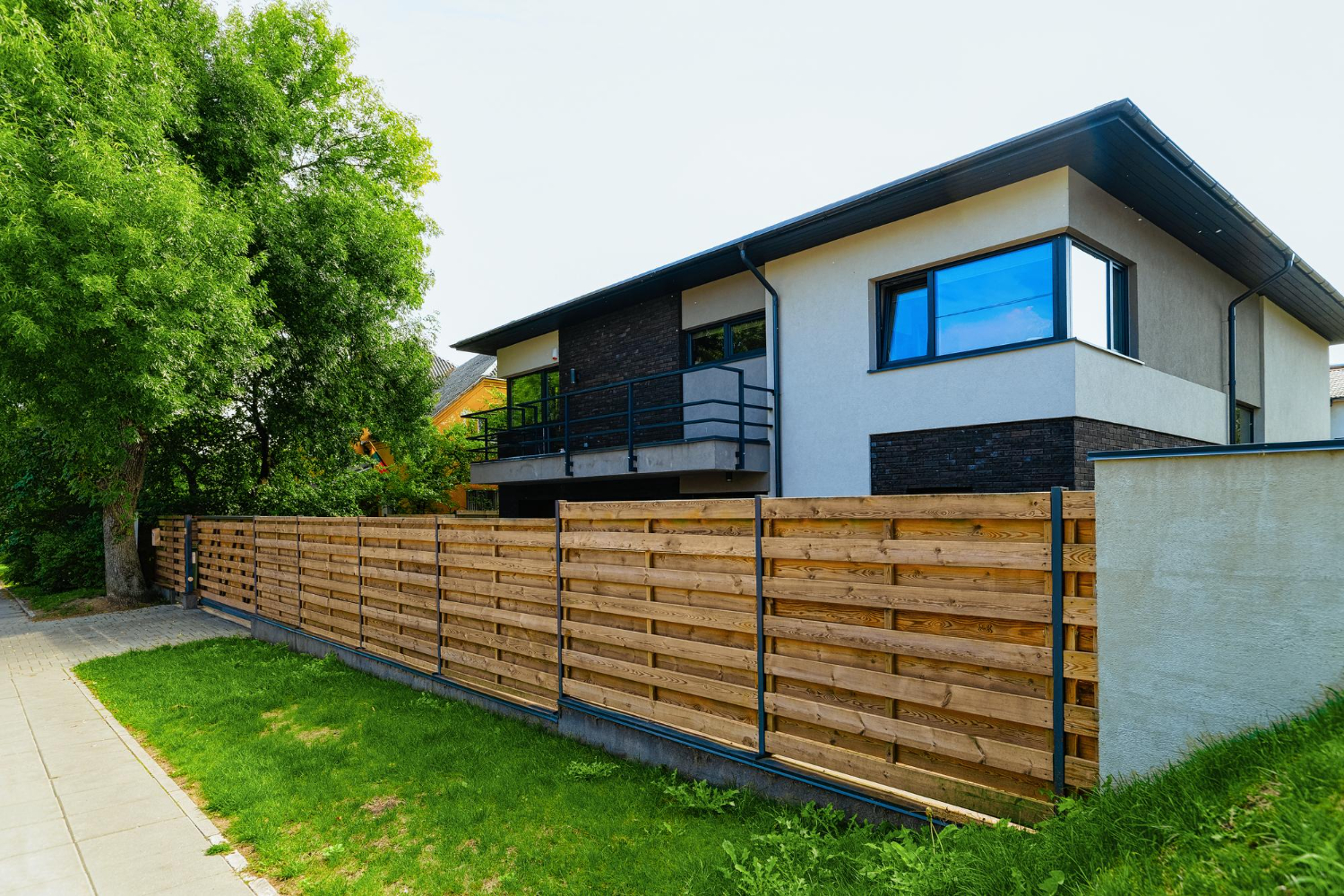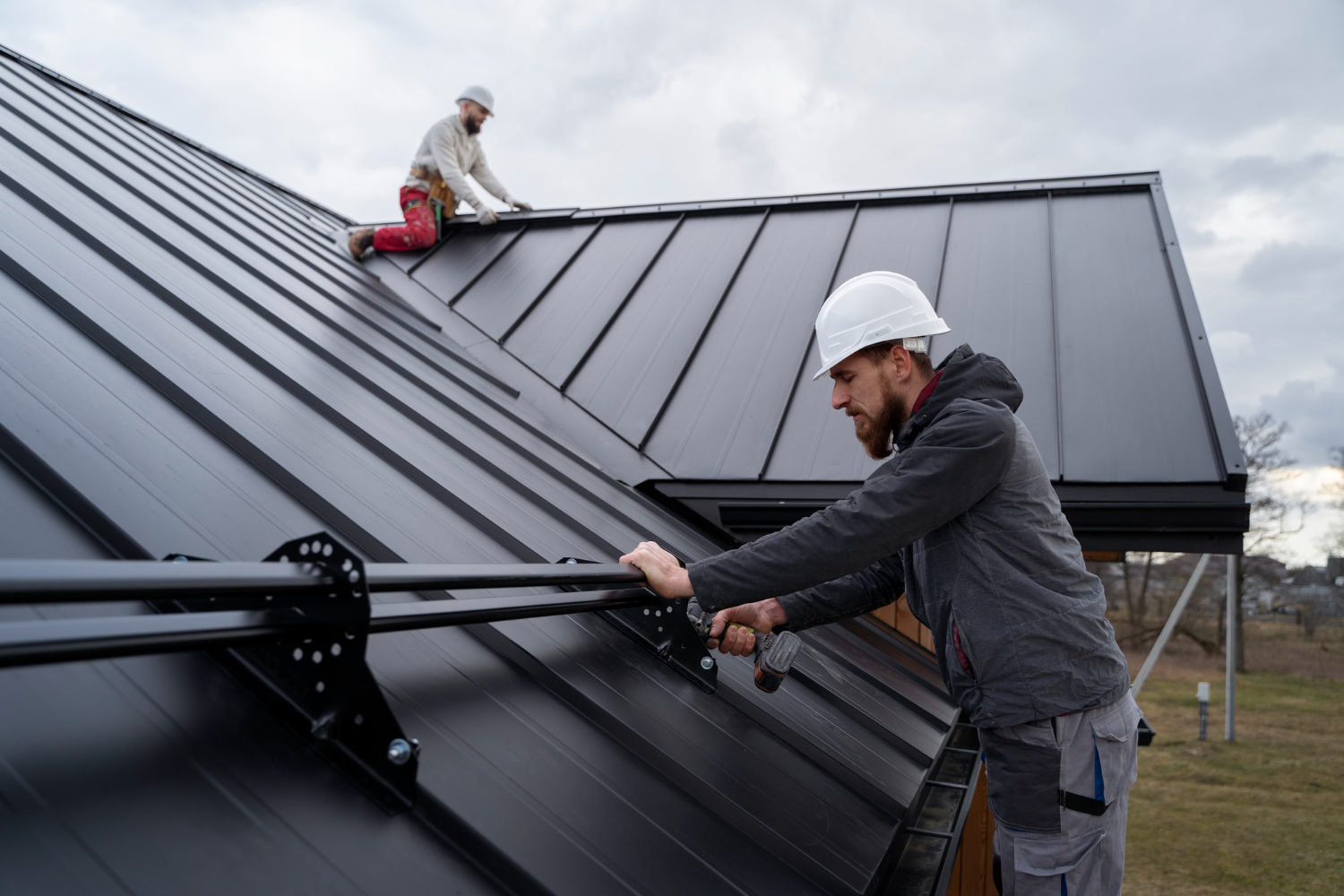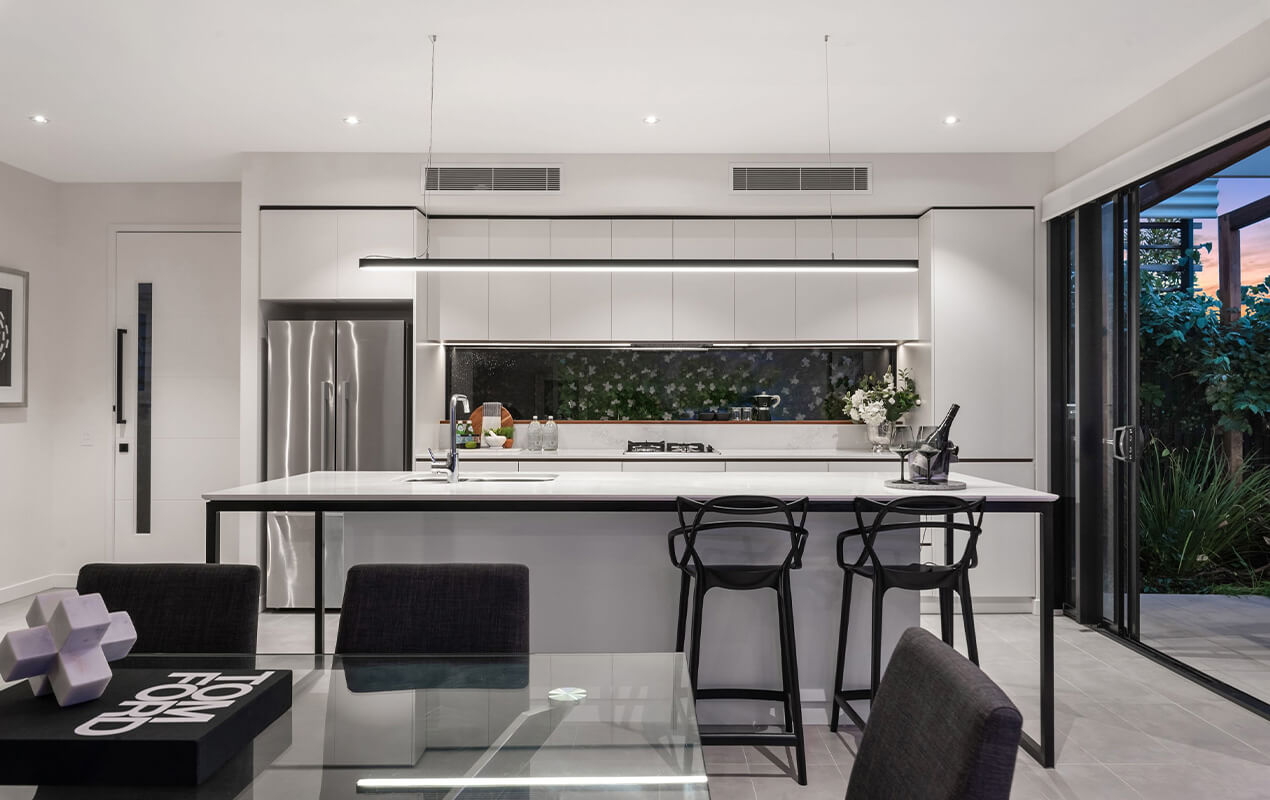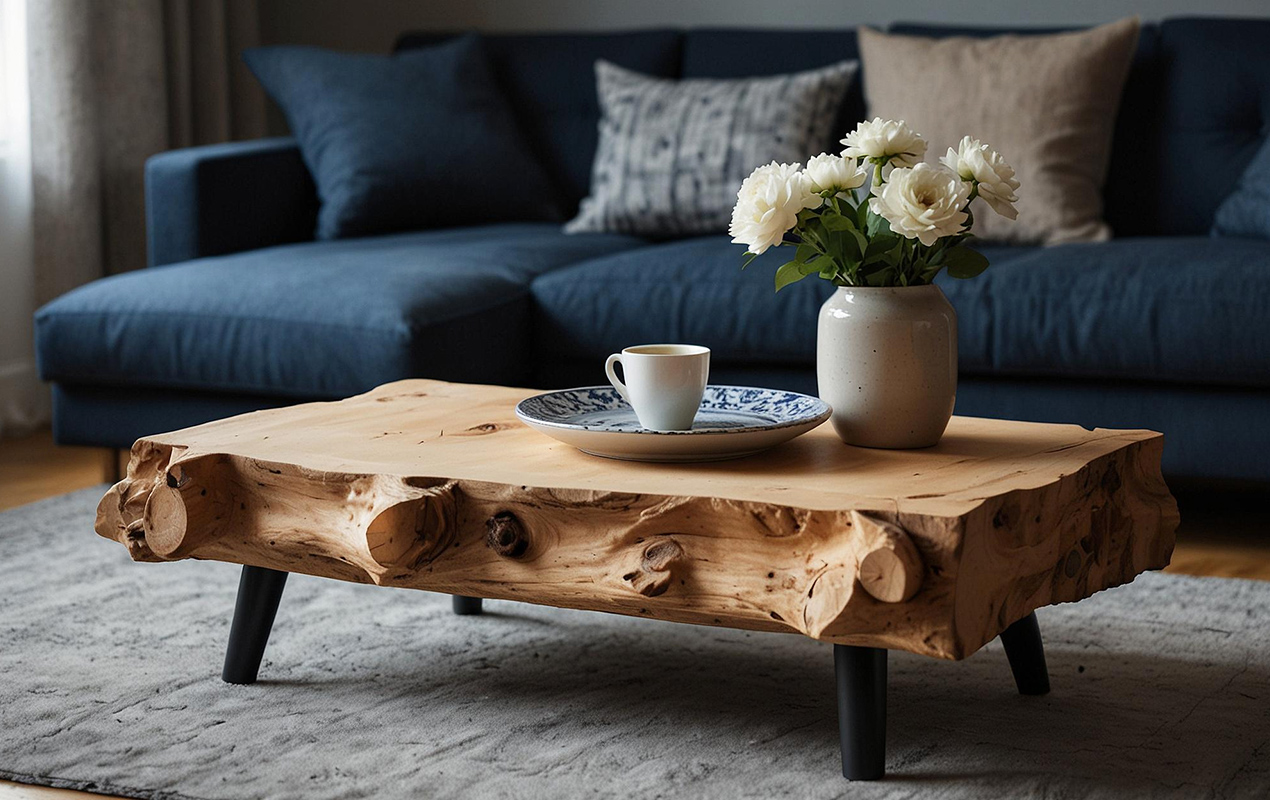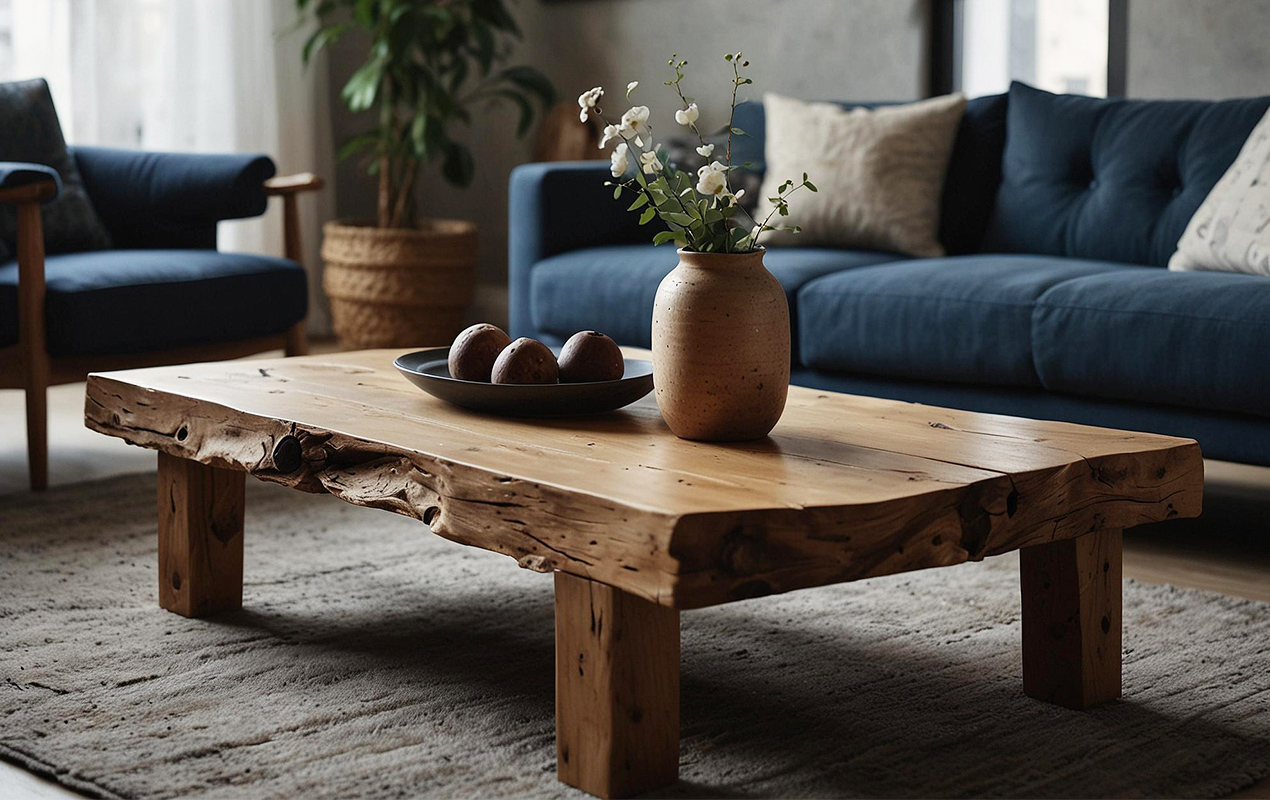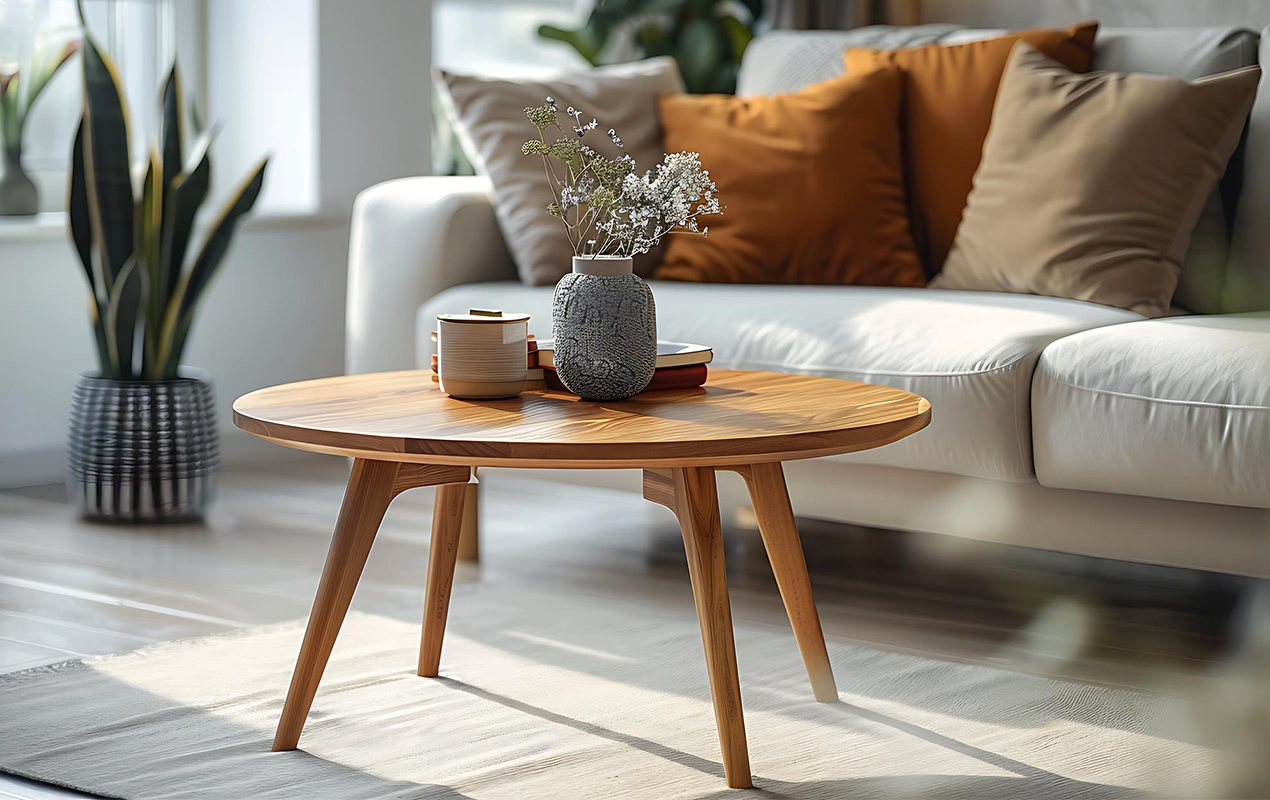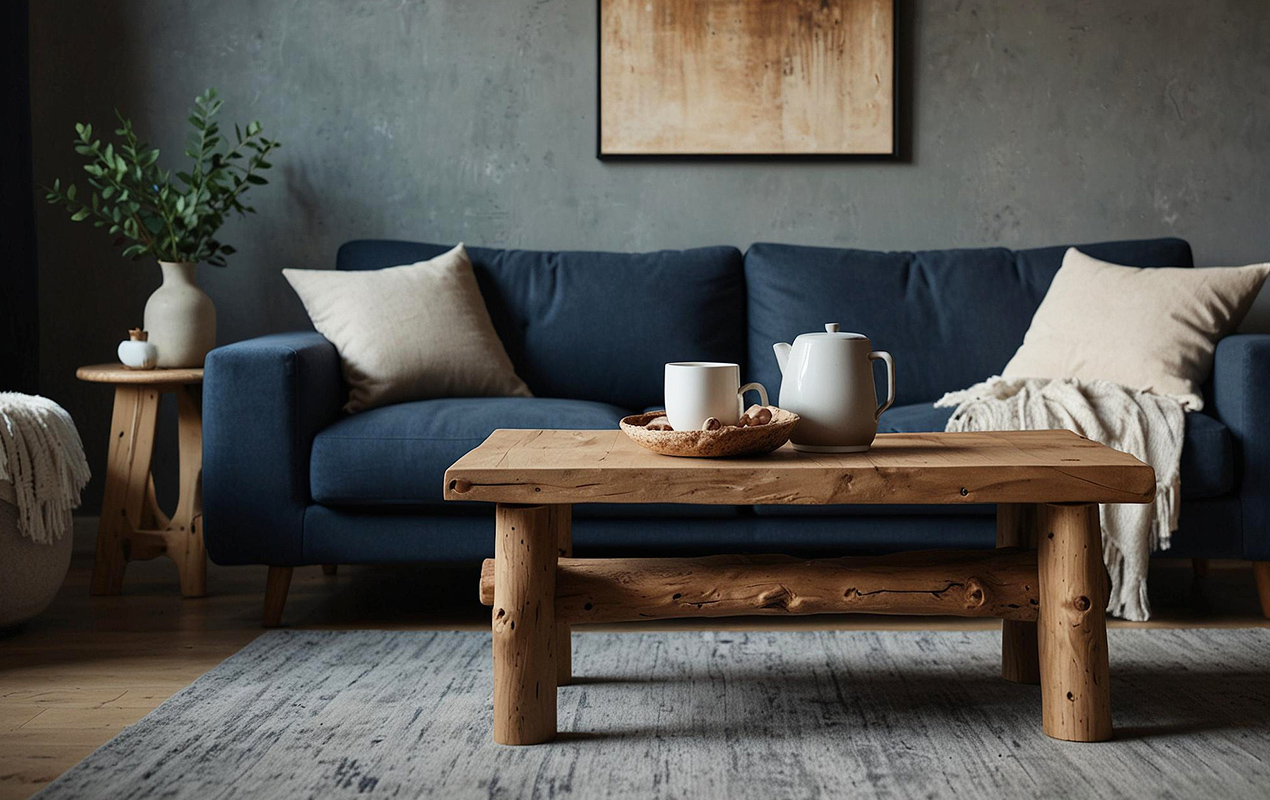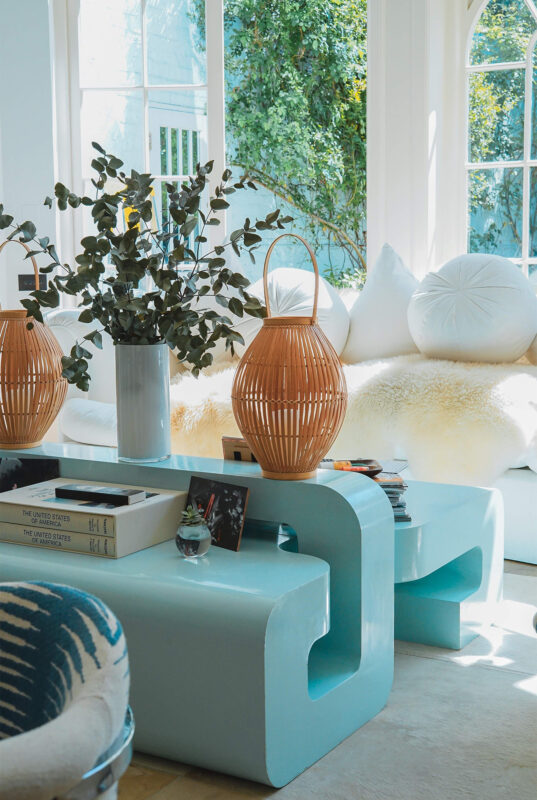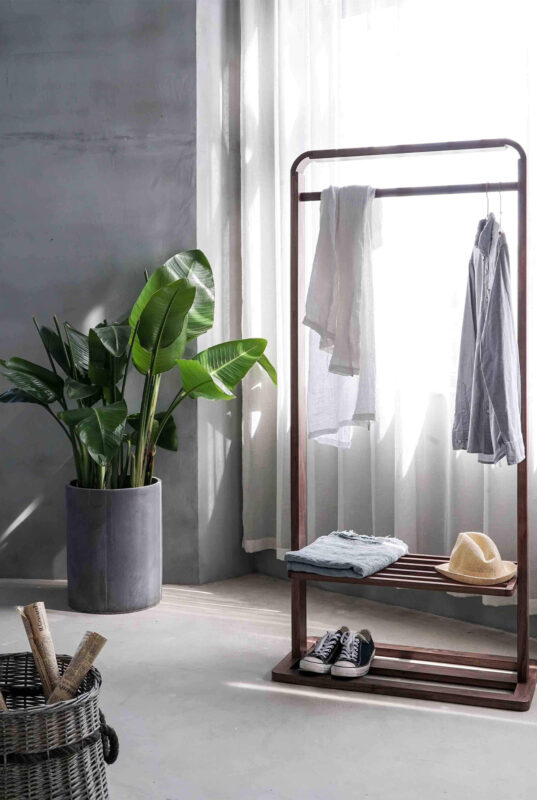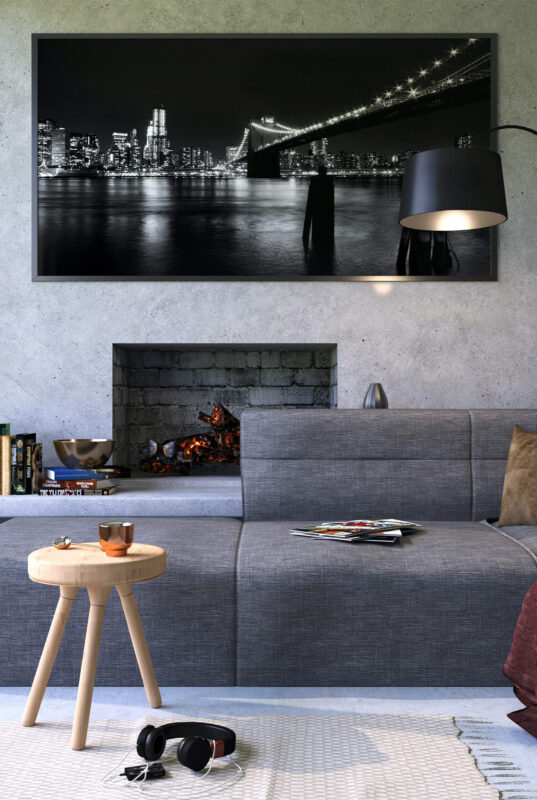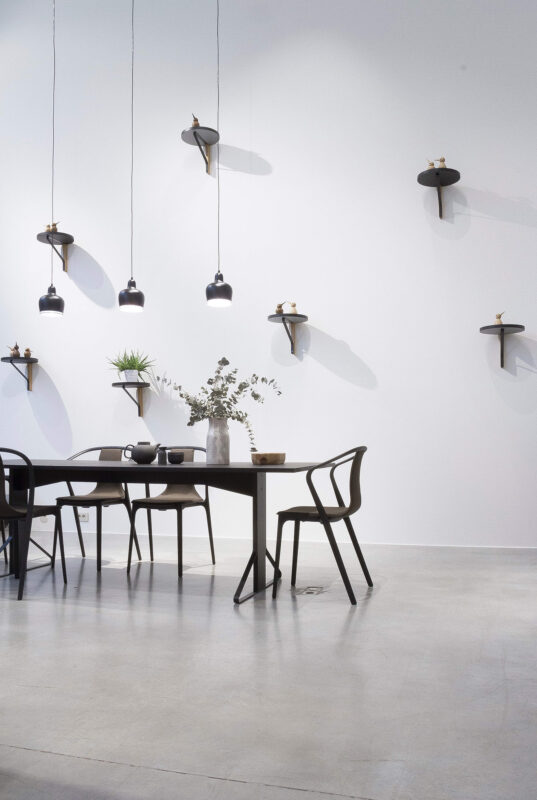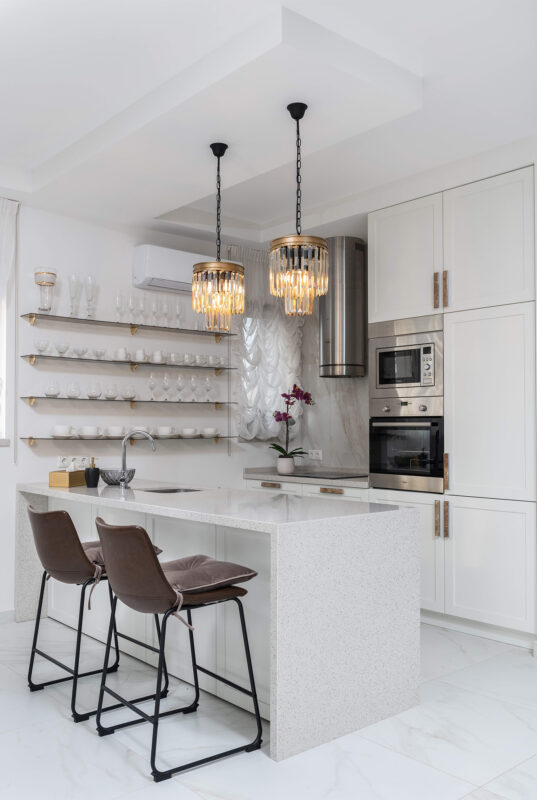Wood You Believe It’s Not Real? 6 Tips to Tell for Sure
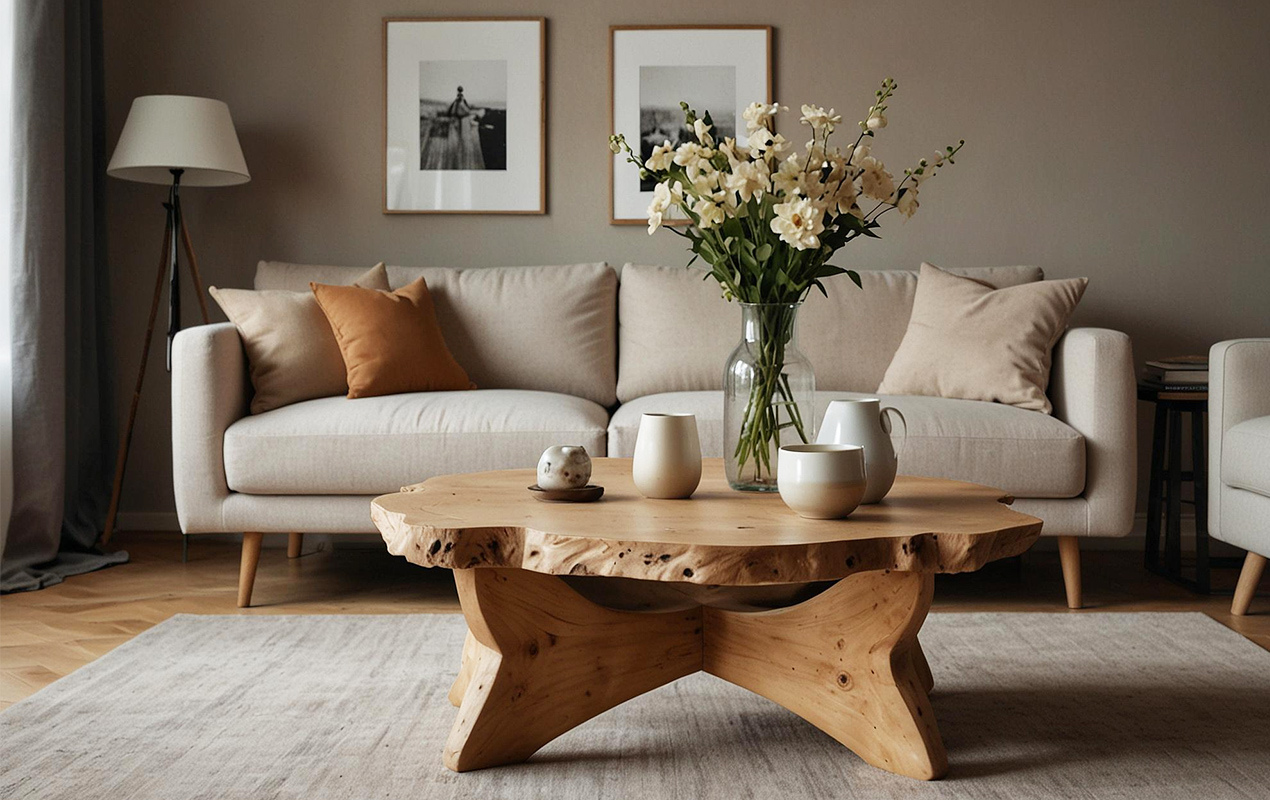
How Can You Tell if a Coffee Table is Solid Wood?
For many of us, our living rooms are the cozy havens where laughter echoes and memories are made, while often being the space that allows us to sink into our favorite armchair, a steaming mug in hand, ready to unwind after a long day. I’m sure it’s not just us forever finding ourselves scrolling through Pinterest, swooning over dreamy living room setups. Capturing that moment when we spot the one – the solid wood coffee table that ties the whole room together. It’s got that warm, inviting glow of natural wood, the kind that makes you want to curl up with a good book and a cup of tea.
But have you ever stopped to wonder if that beautiful piece is truly what it seems?
In a world of fast furniture and fleeting trends, a solid wood coffee table stands apart. It’s an investment in enduring style, a display of craftsmanship, and a promise of warmth and character that only nature can provide. But with clever veneers and laminates flooding the market, how can you ensure your dream table isn’t just a convincing imitation?
Let’s face it – the furniture market can be a bit of a minefield. Misleading labels, clever imitations, and inflated prices can leave even the savviest shopper feeling overwhelmed. You deserve a coffee table that’s as beautiful as it is durable, an investment piece that reflects your style and stands the test of time.
That’s where we come in. In this post, we’ll unweave the riddles of spotting a genuine solid wood coffee table. We’ll provide you with the understanding to confidently navigate furniture showrooms and online listings, ensuring your next purchase is a true reflection of your discerning taste.
So, are you ready to become a furniture detective? Let’s tackle this journey together and uncover the hidden clues that reveal the true nature of a coffee table.
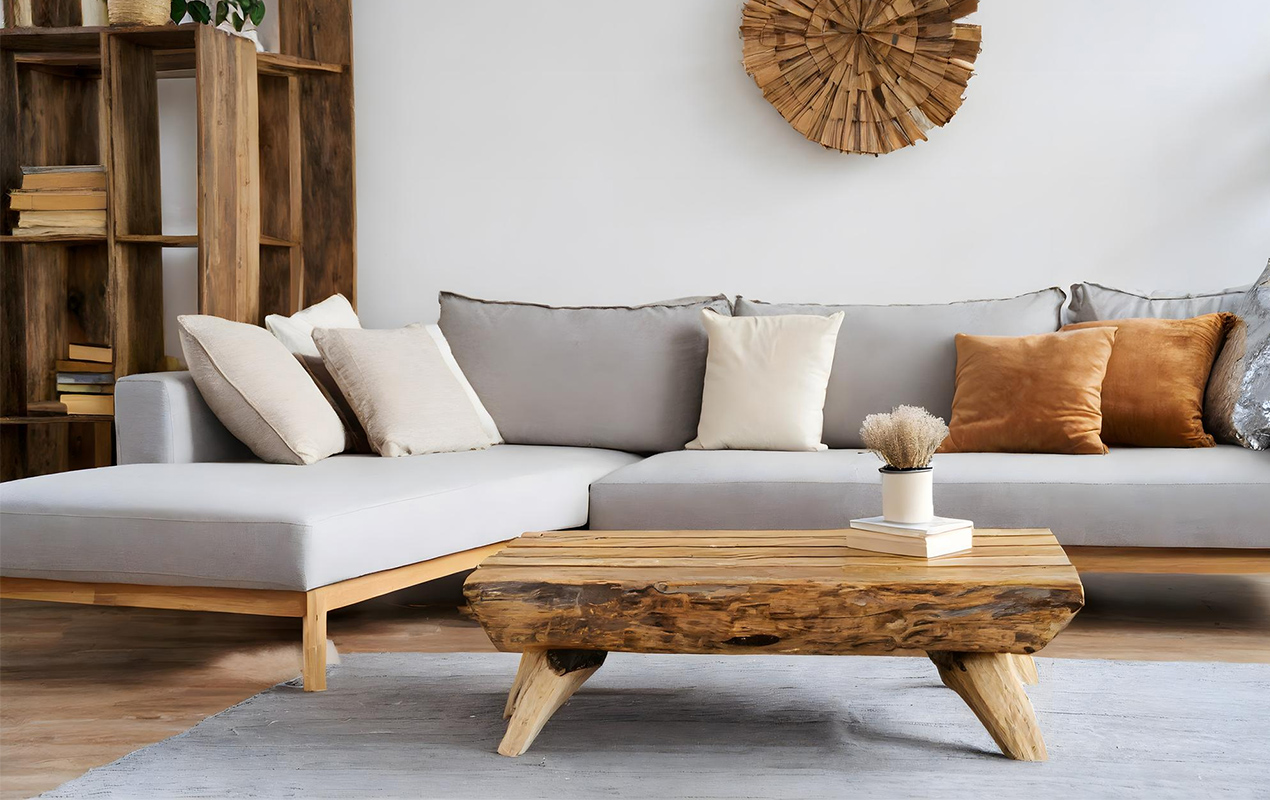
Photo by Emanuel Bustos Orellana from Freepik
Unraveling the Grain: Nature’s Unique Signature
Think of wood grain as nature’s fingerprint – no two pieces are exactly alike. Real wood displays a tapestry of swirls, lines, and subtle color variations that tell a story of growth and time. When you run your fingers across the surface, you’ll feel the gentle ridges and valleys, the subtle texture that speaks of authenticity.
On the flip side, veneer and laminate often lack this depth and character. Their patterns are typically printed or stamped, resulting in a uniform, almost too-perfect appearance. This causes the surface to feel smooth and plasticky, lacking the organic warmth of real wood.
Real Wood vs. The Imposters
- Real wood grain: Look for natural inconsistencies, subtle changes in color, and even tiny knots or imperfections. These are all hallmarks of genuine wood, each piece bearing its own unique markings.
- Veneer/Laminate: These imitations often have a printed or manufactured grain pattern that can appear too perfect, repetitive, or even slightly blurry upon close inspection.
Decoding the Grain
Here are a few tips to help you identify genuine wood grain:
- Look for continuous flow: The grain pattern should flow naturally across the surface, even around curves and corners. Veneer may show abrupt changes or mismatched patterns at joints.
- Check for depth and texture: Real wood has a three-dimensional quality, with subtle ridges and valleys that you can feel. Veneer tends to be flat and smooth, lacking this tactile depth.
- Examine the end grain: If you can see the edges or ends of the wood, look for the distinctive pattern of the growth rings. Veneer often shows a series of thin, uniform layers with no visible end grain.
Remember: Nature doesn’t create straight lines. If the grain appears too perfect, or too consistent, it’s likely a printed veneer trying to fool your eye. Embrace the subtle imperfections and variations – they are the hallmarks that add character and authenticity to your table.
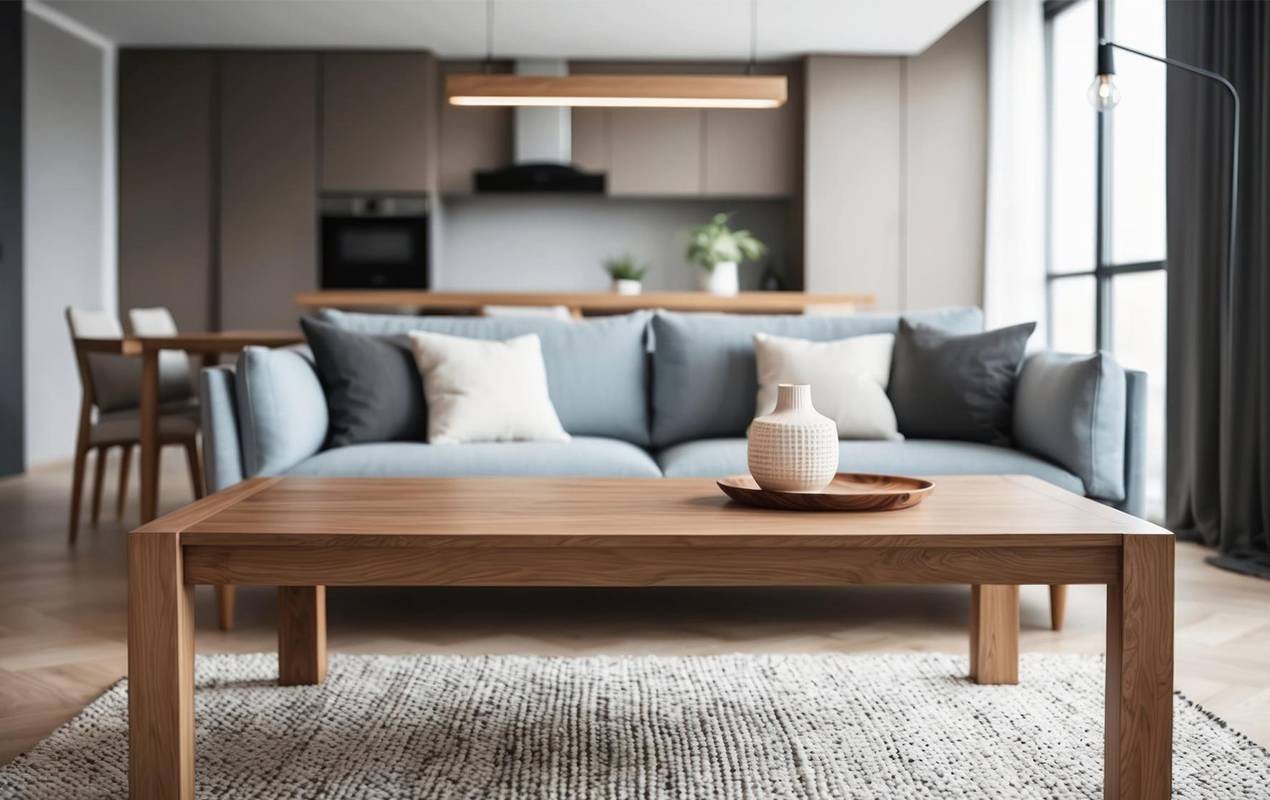
Photo by Starmultikharisma from Freepik
The Undercover: Edges and Undersides
Don’t be fooled by a pretty surface – the true test of a coffee table’s authenticity lies in the hidden details. Like a detective searching for clues, turn your attention to the less visible areas: the edges, corners, and underside of the table. These often-overlooked spots can reveal the true nature of the construction.
Unveiling the Underside
Flip the table over and take a peek at its underbelly. A solid wood table will proudly display its continuous grain pattern, even on the underside. You may even see the marks of craftsmanship, like tool marks or subtle color variations.
In contrast, the underside of a veneer table might reveal a completely different material, often a less expensive plywood or particleboard. Be sure to look out for staples, glue lines, or even patches where repairs have been made. You might spot telltale signs of layering, seams where thin sheets of wood have been joined, or even the backing material peeking through.
Edge It Out: The edges of the table are another prime spot for questioning. Solid wood will showcase consistent grain all the way around, even at the corners. Veneer, being a thin layer applied to a substrate, often shows its true colors at the edges. You might see a distinct line where the veneer ends or even a slight overhang where it hasn’t been perfectly trimmed.
Pay Attention to the Joints: How the different parts of the table are connected can also offer clues. Solid wood furniture often boasts traditional joinery techniques like dovetails, mortise, tenon, or tongue and groove. These intricate joints are a testament to craftsmanship and the use of solid wood throughout. Veneer pieces, on the other hand, typically rely on simpler, less labor-intensive construction methods, often using nails, staples, or glue to secure the veneer to the substrate.
The devil is in the details. Don’t be afraid to get up close and personal with your potential table. A little investigation can go a long way in ensuring you’re investing in a piece that’s built to last.
What to Look For
- Solid Wood Edges: Look for continuous grain that wraps around the corners and edges. The wood should feel consistent with no visible seams or layers.
- Veneer/Laminate Edges: Watch for a thin line or edge banding where the veneer layer ends. The corners might be more susceptible to damage, revealing the underlying material.
- Solid Wood Underside: Expect to see possible signs of craftsmanship. The underside should feel solid and well-constructed.
- Veneer/Laminate Underside: Look for a different material than the top surface, often plywood or particleboard. You might see staples, glue lines, or patches.
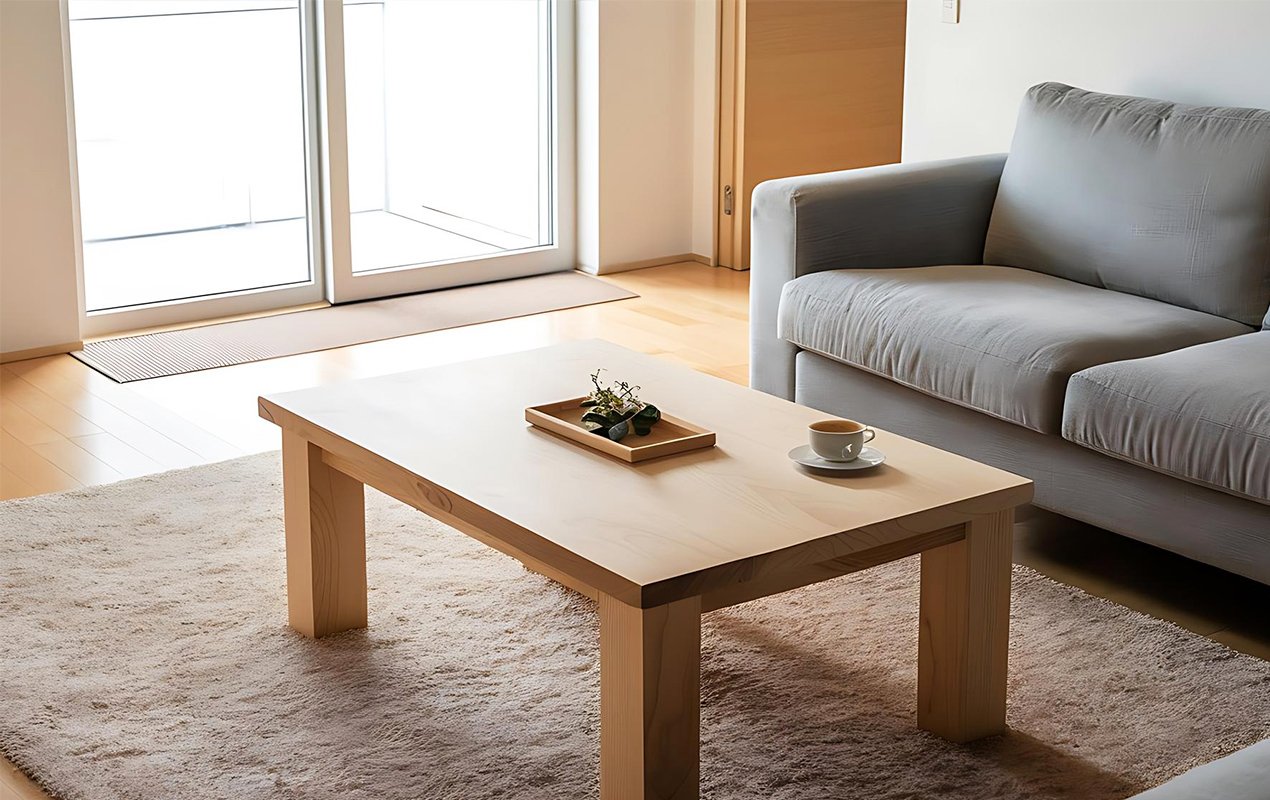
Photo by Stockeryphoto from Freepik
The Sound of Substance: Weight and the “Tap Test”
There’s something satisfying about the heft of solid wood furniture. It exudes a sense of quality that lighter, flimsier pieces simply can’t match. Pick up a corner of the table – does it feel substantial, grounding it firmly in place? Or is it surprisingly light, almost as if it could be lifted with a single finger?
Now, give the table a gentle tap with your knuckles. Solid wood produces a distinctive, dull thud, a sound that resonates with density and strength. Veneer, however, often emits a hollow, tinny sound, betraying its thin construction.
The “Tap Test” – Your Secret Weapon
The tap test is a simple yet effective way to gauge the density and construction of a solid wood coffee table. Here’s how to do it safely:
- Choose a discreet spot: Opt for an inconspicuous area like the underside of the table or a less visible edge.
- Use your knuckles: Gently tap the surface with your knuckles, listening closely to the sound it produces.
- Compare and contrast: If possible, tap a known solid wood piece and a veneer piece to familiarize yourself with the difference in sound.
- Choose your spot wisely: Avoid tapping on delicate areas like glass inserts or decorative elements..
- Trust your instincts: If the sound feels “off” or hollow, it’s worth investigating further.
A Word of Caution
While weight and sound can be helpful indicators, they’re not foolproof. Some engineered wood products, like high-density fiberboard (HDF), can be quite heavy and produce a somewhat dull sound. That’s why it’s important to combine the tap test with other clues, like examining the grain and edges as we’ve previously mentioned to make an informed assessment. The goal is to gather evidence, not jump to conclusions. By using your senses and paying attention to the details, you’ll become proficient at deciphering the true nature of a coffee table.
Craftsmanship: Joinery and Construction
A true solid wood table often showcases joinery techniques. These time-honored methods not only ensure structural integrity but also add artistry and authenticity to the piece.
Take a closer look at the table’s joints, where different pieces of wood connect. Do you see intricate dovetails, interlocking like puzzle pieces? Or perhaps sturdy mortise and tenon joints, where a protruding tenon fits snugly into a corresponding mortise? These are signs of solid wood construction, requiring skill and precision to execute.
Common Joinery Techniques in Solid Wood Furniture
- Dovetails: These interlocking wedge-shaped joints are a good example of fine craftsmanship. They’re incredibly strong and often visible on drawers or corners of tables.
- Mortise and Tenon: This classic joint involves a projecting tenon fitting snugly into a mortise (hole) cut into another piece of wood. It’s commonly used for legs, aprons, and frames.
- Tongue and Groove: This method uses interlocking projections and grooves to create a secure and seamless joint. It’s often found in tabletops and flooring.
Veneer and Laminate Construction
Conversely, veneer and laminate pieces often rely on less labor-intensive construction methods, with the joints sometimes being hidden with wood filler or edge banding, creating a smooth but less durable connection.
What to Look For
- Visible Joinery: Take a close look at the corners, legs, and any visible connections. Do you see signs of dovetails, mortise, and tenon, or other traditional joinery techniques? These are strong indicators of solid wood.
- Hidden Fasteners: If you see exposed screws or nails, it might suggest a less expensive construction method that doesn’t use solid wood throughout.
- Smooth, Seamless Joints: While some solid wood pieces might have subtle gaps or variations in the joints, veneer and laminate often strive for a perfectly smooth, uniform appearance. This can be a clue that the wood is not solid throughout.
The joinery is like the backbone of the table. Strong, well-crafted joints are a sign of quality and durability, while more superficial construction methods might indicate a less robust piece. Take a moment to appreciate the craftsmanship – it’s what sets solid wood furniture apart.
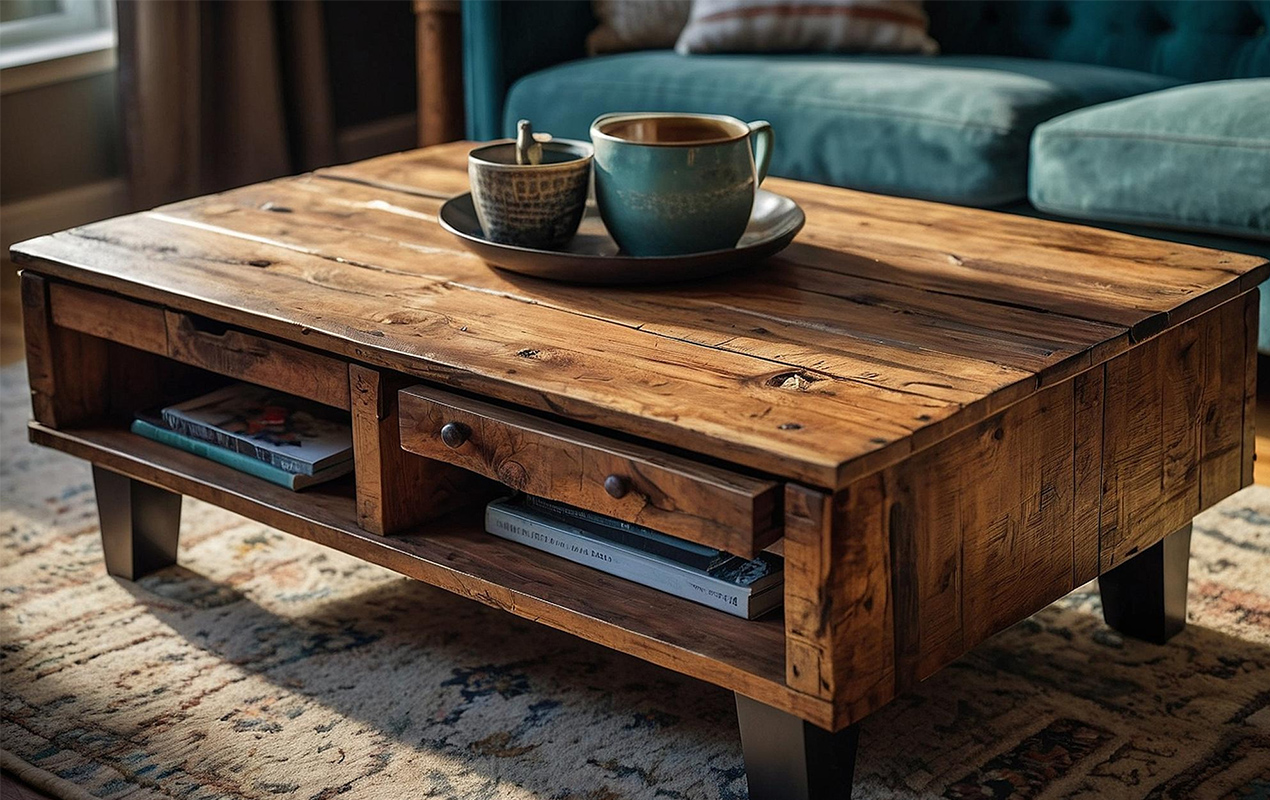
Photo by Razzakdesignworld from Freepik
Embracing Imperfections: Nature’s Markings
In a world obsessed with flawlessness, it’s refreshing to remember that true beauty often lies in imperfections. Solid wood, with its distinctive markings and subtle variations, is a testament to this philosophy. These natural “flaws” are actually signs of authenticity, telling the story of the tree’s life and adding character that manufactured material cannot replicate.
Knots: A Tale of Growth
Knots are formed where branches once grew from the tree trunk. They form swirling patterns and contrasting colors, adding visual interest and rusticity. While some might see them as blemishes, they’re actually evidence of the wood’s origins.
Mineral Streaks: A Touch of Sparkle
Mineral streaks are caused by mineral deposits within the wood, producing subtle lines or bands of color. These highlights add depth and dimension to the grain, like brushstrokes on a canvas. They’re a reminder of the complex processes that shaped the tree over time.
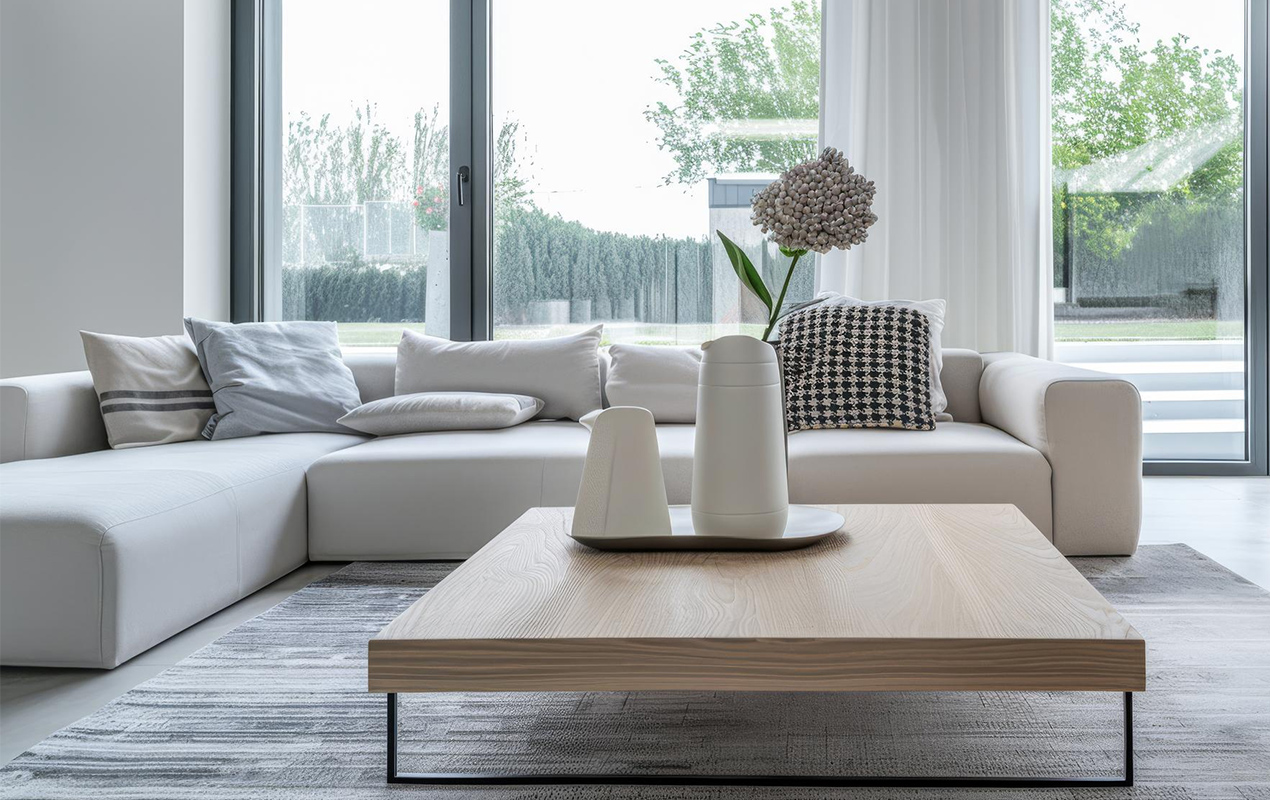
Photo by Juanmataborda from Freepik
Color Variations: A Symphony of Hues
Even within a single species of wood, you’ll find color variations. This is due to factors like the tree’s age, growing conditions, and the specific part of the trunk the wood was sourced from. These shifts in tone create a visual symphony, adding warmth and richness to the aesthetic.
Read More: 20 Driftwood Coffee Tables: Adding Nature’s Art To Your Home
Why Imperfections Matter
- Authenticity: Natural markings prove that the wood is genuine, not a manufactured imitation.
- Uniqueness: Each piece of solid wood is one-of-a-kind, with its own distinct personality.
- Character: Imperfections add depth, visual interest, and a sense of history to the furniture.
- Durability: Knots and mineral streaks are often denser than the surrounding wood, adding strength and resilience.
So, the next time you spot a knot or a mineral streak in a coffee table, don’t dismiss it as a flaw. Embrace it as a sign of authenticity, a reminder of the tree’s journey, and a testament to the beauty of natural materials.
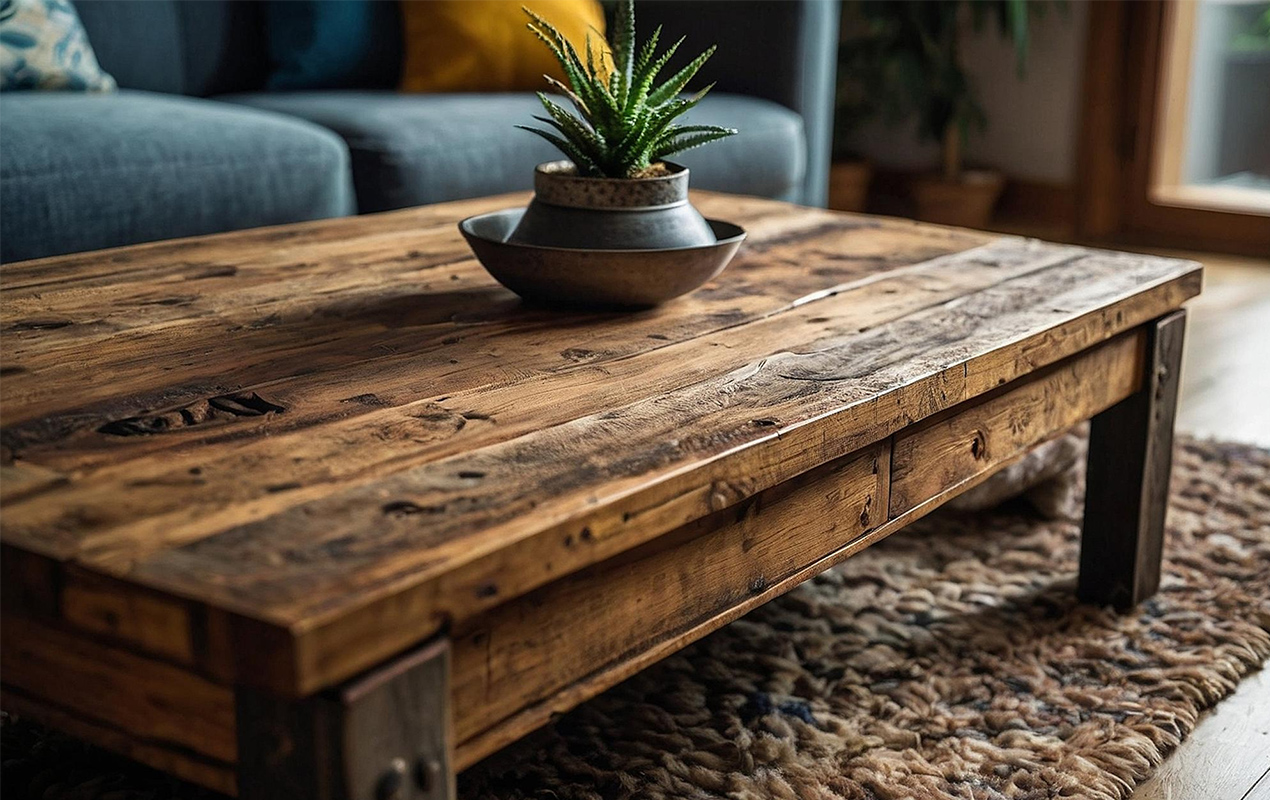
Photo by Razzakdesignworld from Freepik
Beyond the Price Tag: Decoding the Details
While price alone can’t guarantee authenticity, it can offer valuable clues. Solid wood furniture, due to the cost of materials and time needed for craftsmanship, tends to command a higher price than veneer or laminate alternatives. If a coffee table seems suspiciously inexpensive, it’s worth digging deeper to ensure you’re not sacrificing quality.
Reading Between the Lines
Don’t be shy about asking questions and scrutinizing product descriptions. Reputable sellers will be transparent about the materials used. Look for clear terms like “solid wood” or specific wood types like oak, maple, or walnut. Beware of vague phrases like “wood” or “wood finish” which might indicate veneer or laminate.
Label Literacy 101:
- Solid Wood: This indicates that the entire piece, including the top, sides, legs, and drawers, is made from solid wood.
- Wood Veneer: This means a thin layer of real wood is applied over a less expensive substrate, like plywood or particleboard.
- Laminate: This is a synthetic material made from layers of paper or plastic, often printed with a wood grain pattern.
Research is Key
If you’re unsure about a manufacturer or retailer, a little online sleuthing can go a long way. Read reviews, check their website for information about their sourcing and manufacturing practices, and look for certifications or awards that indicate a commitment to quality.
Remember:
- Price is just one piece of the puzzle. Combine it with your newfound knowledge of grain, edges, construction, and markings to make an informed decision.
- Don’t be afraid to ask questions. A knowledgeable salesperson should be able to provide details about the materials and construction of the coffee table.
- Trust your instincts. If something feels off about a piece, or if the seller is evasive about the materials used, it’s probably best to move on.
By being a discerning shopper, you’ll ensure your investment in a coffee table is a wise one. You’ll benefit from the durability, and authenticity of solid wood, creating a space that reflects your style and values.
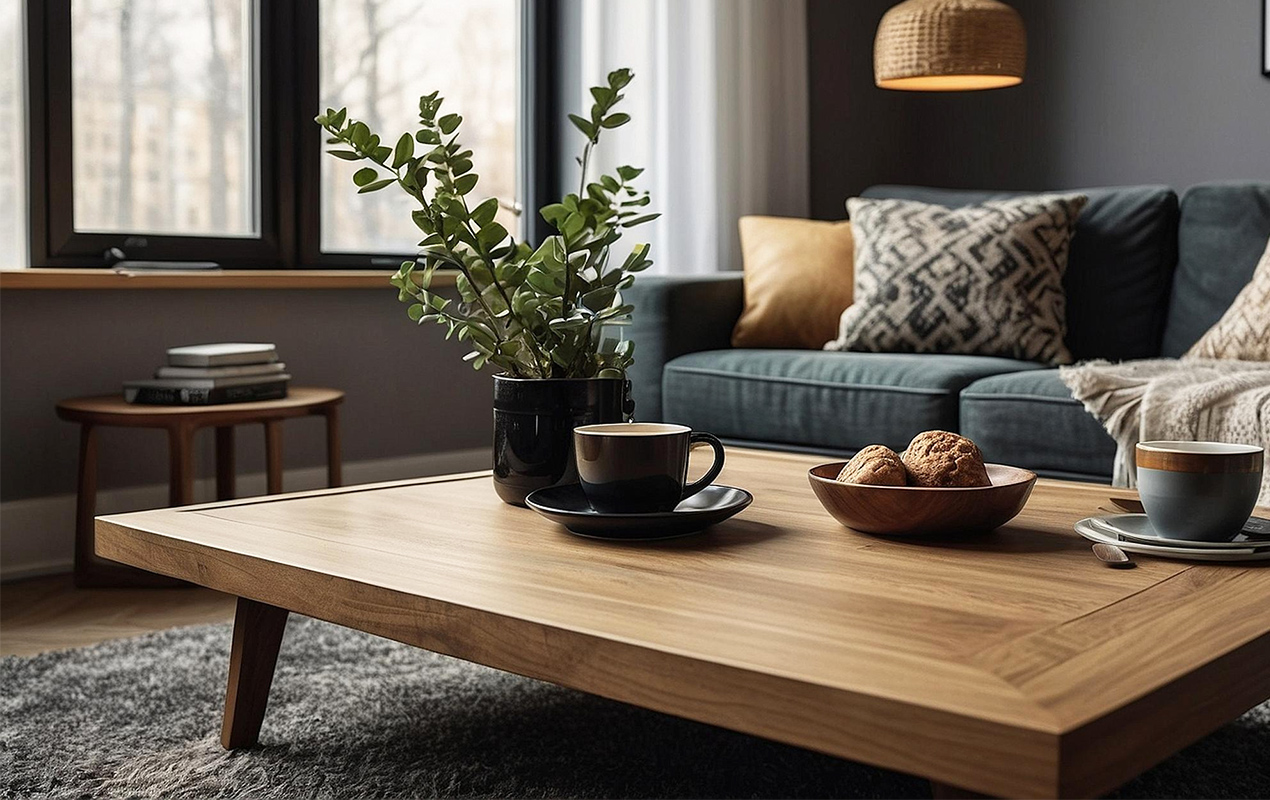
Photo by Razzakdesignworld from Freepik
More Tips and Considerations
You’re now equipped with the essential knowledge to spot a solid wood coffee table. But before you embark on your furniture-hunting adventure, let’s explore a few additional tips and considerations to further enrich your decision-making process.
Weighing the Pros and Cons of Solid Wood Coffee Tables
| Pros | Cons |
|---|---|
| Durability: Renowned for its strength and longevity. | Cost: Generally more expensive than veneer or laminate. |
| Aesthetics: Natural beauty and warmth add elegance. | Susceptibility to Moisture and Temperature: Can warp or crack if not properly cared for. |
| Sustainability: Renewable resource when sourced responsibly. | Maintenance: Requires periodic cleaning and polishing. |
| Versatility: Can be refinished and repaired to update its look. |
Popular Wood Types for Solid Coffee Tables
The type of wood used can significantly impact a coffee table’s appearance, durability, and price. Some popular choices include:
- Oak: Known for its strength, durability, and distinctive grain pattern.
- Maple: Offers a smooth, even texture and a light, natural color.
- Walnut: Boasts a rich, dark hue and a beautiful, swirling grain.
- Cherry: Features a warm, reddish tone that deepens with age.
Each wood type has its own unique characteristics and charm. Consider your personal style and the overall aesthetic of your home when making your selection.
The Final Verdict: Choosing with Confidence
Armed with these insider tips, you’re now ready to undertake your coffee table search with a discerning eye. Remember, a solid wood piece is more than just furniture – it’s an investment in functionality and the satisfaction of owning something truly genuine and long-lasting.
By paying attention to the grain, inspecting the edges, checking the weight and sound, appreciating the joinery, embracing imperfections, and decoding the price and labels, you can confidently distinguish between solid wood and its imitations.
So go forth, explore furniture stores and online marketplaces with newfound confidence. Let your senses guide you, and don’t settle for anything less than the real deal. Your solid wood coffee table, one that will anchor your living room with warmth and style, is out there waiting for you.
DeCasa Collections often feels like a quiet conversation about what makes a home feel settled and lived-in.


